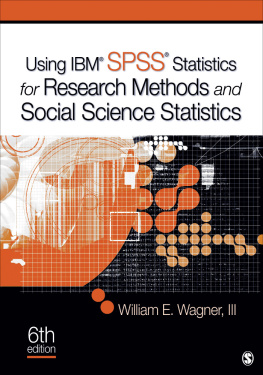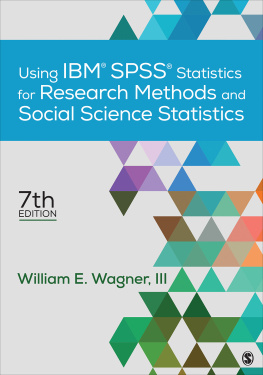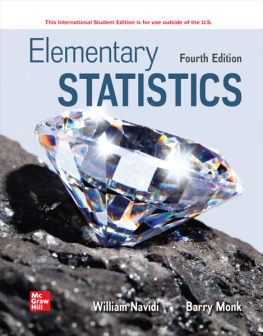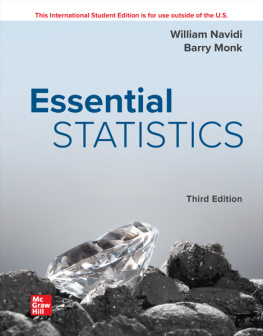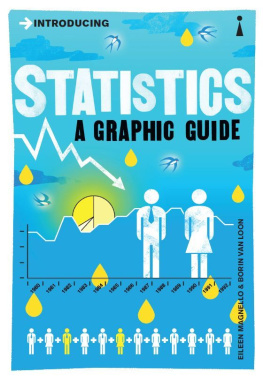First published 2015 by Left Coast Press, Inc.
Published 2016 by Routledge
2 Park Square, Milton Park, Abingdon, Oxon OX14 4RN
711 Third Avenue, New York, NY 10017, USA
Routledge is an imprint of the Taylor & Francis Group, an informa business
Copyright 2015 Taylor & Francis
All rights reserved. No part of this book may be reprinted or reproduced or utilised in any form or by any electronic, mechanical, or other means, now known or hereafter invented, including photocopying and recording, or in any information storage or retrieval system, without permission in writing from the publishers.
Notice:
Product or corporate names may be trademarks or registered trademarks, and are used only for identification and explanation without intent to infringe.
Library of Congress Cataloging-in-Publication Data:
Dressler, William W.
The 5 things you need to know about statistics : quantification in ethnographic research /
William W. Dressler.
pages cm
Includes bibliographical references and index.
ISBN 978-1-61132-392-4 (hardback)
ISBN 978-1-61132-393-1 (paperback)
ISBN 978-1-61132-742-7 (consumer ebook)
1. AnthropologyStatistical methods. 2. AnthropologyMethodology. 3. Ethnology
Research. I. Title. II. Title: The 5 things you need to know about statistics.
GN34.3.S7D74 2015
301.01dc23
ISBN 978-1-61132-392-4 hardback
ISBN 978-1-61132-393-1 paperback
My interest in research methods in anthropology, and especially the mix of qualitative and quantitative methods, began with my undergraduate major in anthropology at Grinnell College. We had a methods seminar required in our junior year that was taught by Doug Caulkins. Doug had studied at Cornell and overlapped briefly there with Pertti J. (Bert) Pelto. Bert was developing his own methods course that eventually would result in the book Anthropological Research: The Structure of Inquiry (1970). Doug used that book in our undergraduate seminar. Then, fast-forward a couple of years, when I was studying anthropology as a graduate student at the University of MissouriColumbia. I took methods there from Mike Robbins, who had been Berts student at Minnesota (and Doug and Mike had been undergraduates together at Carlton College), and again we used Berts book. Well, it seemed only fitting that I should go to the University of Connecticut to do my Ph.D. with Bert, where I took his methods seminar for essentially the third time. So, to Doug, Mike, and Bert, I owe a great deal in formulating my thinking about methods in anthropology.
Along the way I took a number of statistics courses, including from the economist Jim Hamilton at Grinnell and the sociologist Ken Hadden at Connecticut, but none was better than the two-semester sequence I took at Missouri entitled Multivariate Research Design in Anthropology from Bob Benfer. At the time, I didnt realize how much Bob was shaping my thinking in quantitative methods. Bob is a remarkable anthropologist. Hes the only person I know to have published primary research in all four subfields of anthropology. Over the years I have come to appreciate more and more his vision and to realize how lucky I was to have studied under him.
When I first arrived at Alabama I taught in a community medicine department in the medical school, and I became a friend and colleague of the biostatistician Jim Leeper. Jim was always open to me walking into his office, plopping down in a chair, and asking any and all questions. Jim is a widely respected statistician (having chaired sections of both the American Statistical Association and the American Public Health Association), and he is renowned as a teacher at Alabama, recipient of all sorts of teaching awards and in constant demand as a consultant and graduate committee member. I have been extremely fortunate to have drawn on his expertise.
Throughout my career Ive been a part of a network of anthropologists interested in research methods, and its hard to minimize how much all of these people have influenced my thinking. There are many of these colleagues, but I must single out Russ Bernard, Jim Bindon, Jim Boster, Doug Caulkins, Roy DAndrade, Franois Dengah, Ted Graves, Lance Gravlee, Peter Guarnaccia, Penn Handwerker, Jeff Johnson, Kim Romney, Jay Schensul, Steve Schensul, and Sue Weller. I owe them all my thanks for helping me to understand issues of theory and method more clearly.
I also owe a debt of gratitude to my students, including those who have taken my methods seminars here at Alabama, those who have attended workshops I have participated in at the annual meetings of both the American Anthropological Association and the Society for Applied Anthropology, and those who took the short course in survey research methods taught under the auspices of the National Science Foundation. All of these students and their penetrating and insightful questions have required my rethinking of methods in anthropology.
The debt of gratitude that I owe to Kathy Oths, medical anthropologist, methodologist, ethnographer, editor, advisor, bonesetter, organic gardener, and the person I have the good fortune to be married to, is a debt that cannot be measured. Kathy puts up with a great deal from me, not the least of which is that Im liable to launch into a discussion of research methods in anthropology anytime, anyplace, and she is always game for it. She has been my partner in teaching the workshops and short courses just noted, and she has been tireless as a colleague, commenting on, critiquing, and always improving my work. She has heard a lecture called The 5 Things You Need to Know about Statistics And the Rest Is Gravy on numerous occasions. She has been encouraging me for years to write it up, and here it is, plus some additional thoughts.
I refer to much of my own research throughout this book, some of which was supported by research grants from the National Institutes of Health, the Pan American Health Organization, and especially by three research grants over a period of 20 years from the National Science Foundation ( BNS- 9020786, BCS -0091903, and BCS -1026429). I particularly want to thank Stu Plattner and Deb Winslow of the NSF Cultural Anthropology Program for their help and advice over the years. Also, I have carried out research in Brazil in collaboration with my longtime colleagues Jos Ernesto Dos Santos and Mauro Campos Balieiro. Neither started out as an ethnographer, but both became enthusiastic practitioners of mixed-methods research, and I have always benefited from their insight and counsel.
While I was preparing this book, Muzel Chen of the Alabama Digital Humanities Center provided enormous assistance in finalizing the graphics, for which I will be eternally grateful. Finally, my thanks to Mitch Allen and his folks at Left Coast Press, Inc., including Jennifer Collier, Jack Meinhardt, and Ryan Harris, for guiding me through the production process and for their patience and encouragement.
William W. Dressler
February 2015





